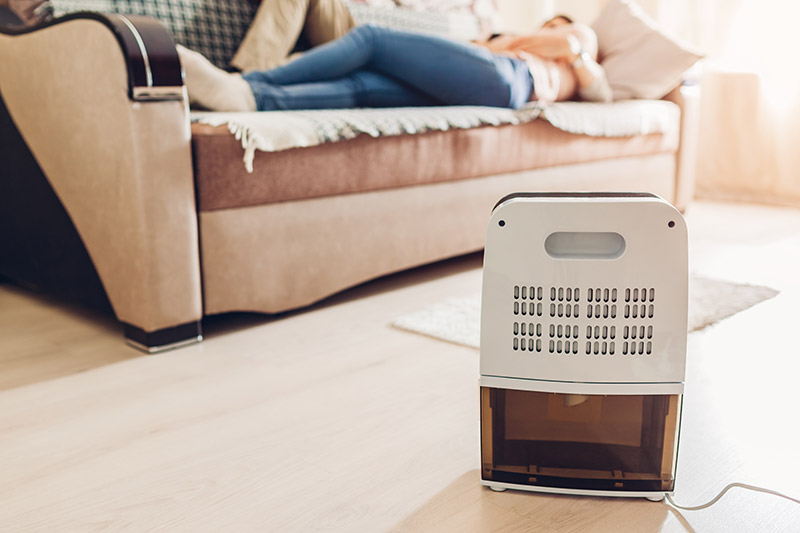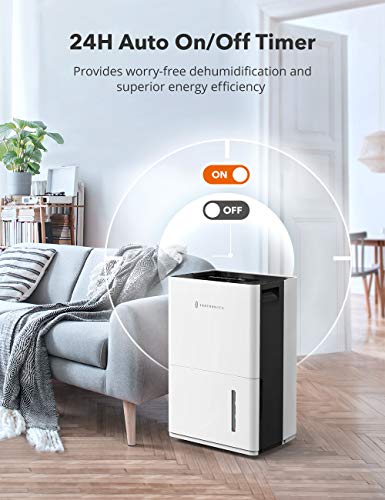Will a Dehumidifier Cool a Room?
This page may contain affiliate links. If you make a purchase through one of our affiliate links, we’ll earn a commission, at no extra cost to you. For more details, please read our disclosure.

Dehumidifiers are a great addition to the home, particularly if you live in an especially hot climate. Typically hot temperatures correlate with higher levels of humidity, which is why the use of dehumidifiers increases significantly in the warmer, summer months.
Excess humidity in a home can have several negative impacts, the most obvious one being the uncomfortable, sticky, hot feeling that it leaves us with. While it’s true that often high temperatures and high humidity go hand-in-hand, in some cases solving just one of these issues might be enough to solve the problem entirely.
People often say that when using a dehumidifier, their home feels much cooler in temperature, as well as less humid. Some dehumidifiers come with built-in air conditioning systems, which will definitely work to reduce the temperature in your home, but what about regular dehumidifier systems? Will a dehumidifier cool a room and leave you with a more comfortable, cool living space?
We’re going to take a look at exactly what a dehumidifier does and whether or not it could actually lower your home’s temperature. We’ll also consider how to maximize the effectiveness of your dehumidifier in creating a cool, fresh space with better air quality and reduced bacteria or mold growth.
Related: Can a Diffuser Be Used as a Humidifier?
Will a Dehumidifier Cool a Room?
A dehumidifier does not work to cool a room, it won’t have any impact on the overall temperature of your home. However, reducing the relative humidity levels, it can make your space feel much cooler and more comfortable.
When it needs to cool down, the human body produces sweat. In spaces with low relative humidity, this excess moisture on the skin is able to evaporate, being absorbed by the surrounding air particles and leaving us feeling much cooler. However, when relative humidity is high, the air particles are already saturated with water vapor and are unable to effectively absorb the moisture from our skin. This leads to that hot, sticky, uncomfortable feeling we get in areas with high humidity.
In a sense, this tricks the body into thinking the temperature is lower when the relative humidity is lower. This is because typically, cooler air tends to hold less moisture, so humidity levels tend to be higher when the temperature is higher.
While a dehumidifier won’t reduce the temperature of your room, it will make your body think that the temperature has decreased – which could be a nice little bonus alongside the many other benefits of using a dehumidifier that we listed earlier.
Related: Dehumidifier Benefits and Side Effects You Need to Know
What is a Dehumidifier and How Does it Work?
 Ivation Energy Star Dehumidifier
Ivation Energy Star Dehumidifier
A dehumidifier works to remove excess moisture from the air, reducing the relative humidity levels within your home. They work by drawing in air, extracting water vapor, and then expelling the dry air back into the surrounding atmosphere.
Dehumidifiers are very popular and are put to use in many homes and public spaces, particularly in the summer months when humidity levels tend to creep up. They provide a whole host of health benefits, such as:
- Alleviating symptoms of asthma
- Helping to decongest the airways
- Promoting healthy, restful sleep
- Improving the overall air quality in your home
In addition to this, dehumidifiers will prevent the growth of potentially harmful bacteria within your home. Black mold and mildew growth are common in homes with high levels of relative humidity. These can be detrimental to your health and can quickly spread out of control if left untreated. By removing excess moisture from the air, you will see less condensation on your surfaces, and therefore less mold or mildew growth.
| Image | Product | Our Rating | Price |
|---|---|---|---|
Top Choice  | Kesnos 70 Pint Dehumidifier
| 9.8 | Check Price on Amazon |
Best Value  | hOmeLabs Dehumidifier
| 9.7 | Check Price on Amazon |
 | Honeywell Energy Star Dehumidifier
| 9.5 | Check Price on Amazon |
Related: What’s the Difference Between an Air Purifier and a Humidifier?
How to Get the Best Results from Your Dehumidifier
If you’re looking to invest in a dehumidifier to regulate the humidity levels within your home and also want to leave your space feeling much cooler and more comfortable for you and anyone else in your household, there are a few things you can do to increase the effectiveness of your unit in helping you to achieve these results.
 Kesnos 70 Pint Dehumidifiers for Spaces up to 4500 Sq Ft
Kesnos 70 Pint Dehumidifiers for Spaces up to 4500 Sq Ft
1. Use it Along with an Air Conditioning Unit
When looking into how will a dehumidifier cool a room it is best to combine it with an air conditioning system as it is likely to give you the best results if you are looking to reduce humidity levels and lower the temperature in your home.An air conditioning unit works by removing the warm air from within your home and replacing it with cool air until your optimal temperature has been reached. The exact way your air conditioning unit works will depend on the specific system in use.
By using a dehumidifier alongside your air conditioning unit, you’re likely to greatly increase in efficiency of both machines. The dehumidifier will remove excess moisture from the air, in turn allowing the air conditioner to cool the space more easily. This means the optimal temperature can be reached faster, saving energy and keeping your electricity costs to a minimum.
| Image | Product | Our Rating | Price |
|---|---|---|---|
Top Choice  | BLACK+DECKER BPACT08WT Portable Air Conditioner
| 9.6 | Check Price on Amazon |
 | SereneLife SLACHT128 Portable Air Conditioner Compact Home AC Cooling Unit
| 9.4 | Check Price on Amazon |
 | Frigidaire Window-Mounted Room Air Conditioner
| 9.4 | Check Price on Amazon |
Related: Do Dehumidifiers Use a Lot of Electricity?
If you’re going to use an air conditioning system and dehumidifier at the same time, be sure to use any pre-setting functions on the machines so that once your desired humidity level and temperature are reached, the machines shut off. Otherwise, it can be easy to overuse the machines, leading to humidity levels that are too low, which can also have multiple negative impacts on your health.
In the summer months, it is recommended that humidity levels within the home should be kept at around 40%-50%, and slightly lower in the wintertime, so this is what you should be aiming for.
2. Find the Right Dehumidifier for You and Your Space
The common mistake people make when installing a dehumidifier into their home is not doing adequate research on what type and size of dehumidifier is needed for that specific space.
Dehumidifiers come in numerous sizes and capacities, so of course, it makes sense to use a larger unit in an open floor plan and in large spaces within the home.
These days, most new dehumidifier models are highly efficient and cost-effective, but they do all come with slightly different functions and specialties. Always try to opt for a machine with a built-in self-regulating mechanism. This means that the machine will measure humidity levels within the space and shut off once your chosen levels have been met, increasing efficiency and lowering energy costs.
 TaoTronics Energy Star Dehumidifier
TaoTronics Energy Star Dehumidifier
3. Properly Maintain Your Dehumidifier
Finally, ensure that you’re properly maintaining your dehumidifier, particularly if you’re using it regularly. This means cleaning out the filters, pipes, and water tank thoroughly at regular intervals. Because of the nature of the machine, bacteria and mold can quickly build up within the inner mechanisms, if these spores are then emitted back into the air, this can be extremely harmful to your health.
It’s also important to optimize the placement of your dehumidifier. When you’re hoping to cool your space as well as lower humidity levels, it’s a good idea to keep windows open as much as possible to allow maximum ventilation in the space and create a cross breeze which will instantly leave your space feeling much cooler and more comfortable.
Avoid placing the dehumidifier right next to or beneath windows, as this might limit its effectiveness. Instead, place the dehumidifier in the center of the space you wish to cool.
Related: The Best Place to Put a Humidifier
| Image | Product | Our Rating | Price |
|---|---|---|---|
Top Choice  | Kesnos 70 Pint Dehumidifier
| 9.8 | Check Price on Amazon |
Best Value  | hOmeLabs Dehumidifier
| 9.7 | Check Price on Amazon |
 | Honeywell Energy Star Dehumidifier
| 9.5 | Check Price on Amazon |
Frequently Asked Questions
Can I use a dehumidifier instead of an air conditioner?
A dehumidifier may make a room feel cooler by reducing humidity, but it will not actually lower the temperature of the air in the room. It might make the room more comfortable, but if you’re looking to actually cool a room, air conditioning will be much more effective. It’s a good idea to use a dehumidifier and an air conditioner together.
How much cooler does a dehumidifier make a room?
A dehumidifier will not actually make a room cooler. However, it may make the air in the room much more comfortable, and by reducing humidity, the air may feel a few degrees cooler.
What’s better, an air conditioner or a dehumidifier?
They serve different purposes. If you’re looking to cool a room, an air conditioner will be better. If the space is humid, a dehumidifier will be better for increasing comfort by reducing the relative humidity. In the summer months and during warm weather, it’s ideal to use both an air conditioner and a dehumidifier together.
Is it cheaper to run a dehumidifier or an air conditioner?
In general, dehumidifiers are less expensive to run than air conditioners. However, it can depend on the type of unit, as well as its age and efficiency.
Should I run a fan with a dehumidifier?
Yes, it’s perfectly fine to run a fan and a dehumidifier together in the same room.
Does an air conditioner remove humidity?
Yes, it does, to some extent. However, a dehumidifier is much more effective at significantly reducing humidity. If you have high levels of humidity, an AC unit is probably not enough to reduce it to an appropriate level.
Why is my house so humid even with air conditioning?
Air conditioners will remove some humidity from the air, but that is not their primary purpose. The higher the humidity levels are, the more likely you are to need a dedicated dehumidifier. You can run a dehumidifier and an air conditioner together for the best results and the most comfortable environment.
Related: The Best Garage Dehumidifiers
Final Thoughts on Will a Dehumidifier Cool a Room?
The answer to the question, “Will a dehumidifier cool a room?” is no. Your dehumidifier won’t actually reduce the temperature in your home, but it can definitely be used to extract excess moisture and leave you feeling much more comfortable.
Using a dehumidifier in the summer months or in hot climates can definitely help the body to cool down more efficiently, particularly if used in conjunction with an air conditioning unit.
